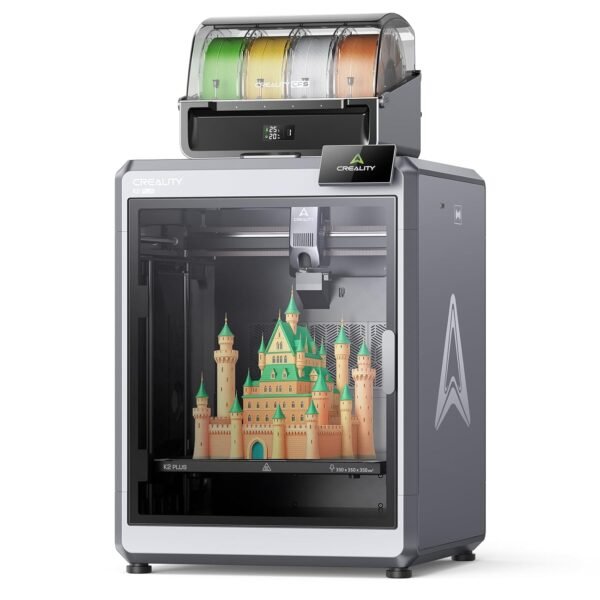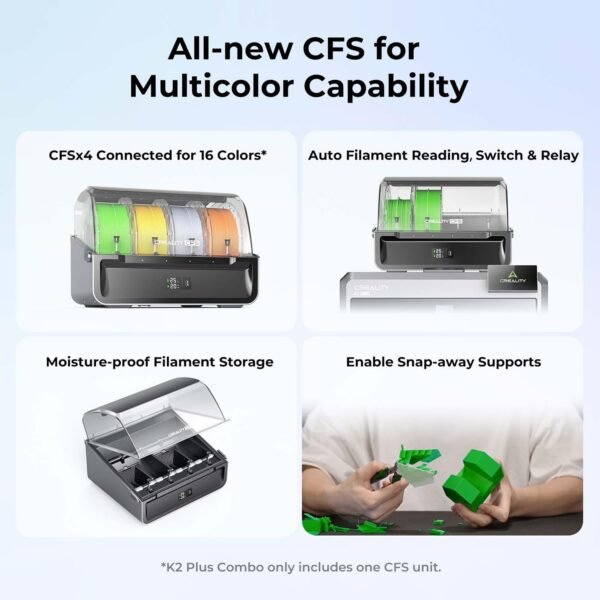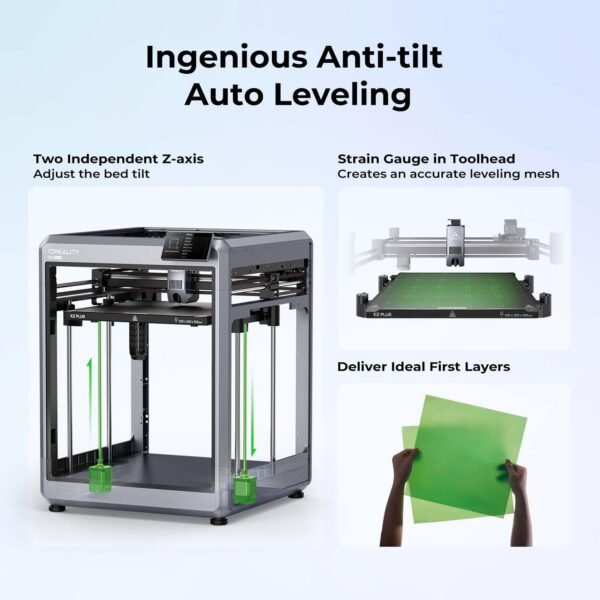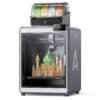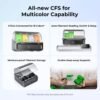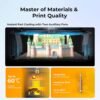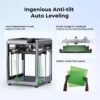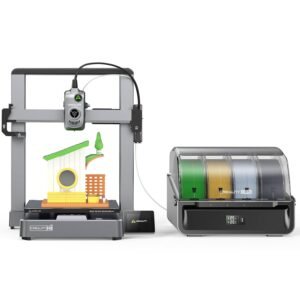Creality K2 Plus Combo 3D Printer Review High-Speed Multi Color Printing Powerhouse
Creality K2 Plus Combo 3D Printer Review High-Speed Multi Color Printing Powerhouse
- Multi Color Printing with All-new CFS enables up to 16-color 3D prints without the need for post-painting, thanks to automatic filament selection and relay capabilities.
- The 350350350mm build volume supports larger objects and batches, making it ideal for professional-level projects.
- Equipped with 600mm/s high-speed printing using industry-grade FOC step-servo motors, it accelerates rapidly while maintaining quiet operation.
- The active chamber heater reaching 60°C ensures strong prints in high-end materials like ASA and PPA, enhancing durability.
As an Amazon Associate I earn from qualifying purchases.
Description
Highlights of the Creality K2 Plus Combo 3D Printer
Testing this Creality K2 Plus Combo 3D Printer has been quite an experience, especially with its multi-color printing capabilities powered by the all-new CFS (Creality Filament System). One standout feature is the ability to house four filament spools in a single CFS unit, and by linking four units together, you can print with up to 16 colors without needing to paint afterward. This alone saves a ton of time and effort in post-processing. The RFID filament detection is smart enough to automatically select and switch filaments, which reduces manual errors and interruptions. I found the automatic relay feature particularly useful when a filament runs out—it seamlessly switches to a similar filament, keeping prints going smoothly.
Large Build Volume and Robust Design
This printer isn’t just about colors; it’s also a powerhouse with a generous 350 x 350 x 350 mm build volume, which is perfect for larger parts or batch printing. The heavy-duty aluminum and metal frame gives it a sturdy feel that minimizes vibrations, enhancing print precision. The machine weighs around 70 pounds, which means it’s solidly built and not likely to wobble during fast printing sessions. Handling bigger models or multiple parts at once felt effortless, and I appreciated that the industry-grade FOC step-servo motors on all XYZ axes provide smooth and reliable movement.
High-Speed Printing with Precision
The 600mm/s high-speed printing capability caught my attention immediately. This machine doesn’t just print fast; it accelerates at an astonishing 30,000 mm/s², delivering prints at a remarkable flow rate of 40 mm³/s. The step-servo motor system is noticeably quieter than typical 3D printers, which is a blessing for home or office environments. While this speed sounds impressive, it’s the combination of speed and precision that truly stands out. The printer’s dimensional accuracy reaches 0.05 mm, thanks to the input shaping algorithm and the machine’s hefty frame that reduces vibrations. Complex designs with fine details came out clean and sharp, which definitely impressed me.
Mastering Materials and Print Quality
The active chamber heater maintaining temperatures up to 60°C is a great feature for printing with advanced materials like ASA and PPA. This heated environment enhances layer adhesion and reduces warping, which can be a headache with high-performance filaments. The direct drive extruder assembly supports nozzle temperatures up to 350°C, making it suitable for a broad range of filaments including engineering plastics. I didn’t encounter any clogging issues, and maintenance was straightforward—just the thing for users who want reliability without constant tinkering. Cooling fans on the chamber sides ensure efficient part cooling, which helped me achieve smooth surfaces and strong structural integrity.
Dual AI Cameras and Smart Automation
This machine is packed with automation. The dual AI cameras are a clever addition: one monitors the chamber to detect failures like filament spaghetti or idling, while the other watches the toolhead to optimize filament flow. This reduces common printing errors and wasted material. The printer also features 18 smart sensors that keep everything under close surveillance, which means less babysitting during prints. Another neat touch is the independently motorized dual Z-axis, allowing the printer to auto-adjust bed tilt before auto-leveling. This results in a precise first layer every time—a relief for anyone who’s battled uneven prints.
Drawbacks to Consider
Despite many strengths, I noticed some downsides worth mentioning. The printer’s size and weight, while beneficial for stability, make it less portable and require a dedicated space. The learning curve is a bit steep, especially for beginners who might find the multiple smart features overwhelming initially. Although the multi-color printing is fantastic, managing the four linked CFS units can be tricky, requiring regular calibration to avoid filament jams or color swaps. The price point reflects its advanced features, which might be a stretch for hobbyists on a tight budget. Finally, the customer support response times could be improved, as I encountered delays when seeking assistance.
Competing Brands and Alternatives
Compared to popular competitors like the Prusa MK4 or the Ultimaker S5, this printer excels in multi-color printing and automated filament management, features not as advanced in those models. Its 600mm/s printing speed is noticeably faster than most desktop 3D printers, which is a game changer for productivity. However, the Prusa MK4 offers more beginner-friendly software and a larger user community, which can be helpful for troubleshooting. The Ultimaker S5 shines with its industrial-grade reliability and extensive material compatibility, but it lacks the same level of automation and multi-color capacity. In short, this printer stands out for users who value speed, color versatility, and automation but might be less appealing for casual users who prioritize simplicity and support.
Value Assessment and Price Worthiness
Considering its advanced features like the multi-color CFS system, high-speed step-servo motors, dual AI cameras, and large build volume, the printer offers solid value for its price. It’s clearly designed for prosumers or small businesses needing efficient, high-quality multi-material prints. While it may not be the cheapest option on the market, the investment feels justified by the time saved in post-processing and the quality of output. Those who want to print complex, multi-color models without manual filament swaps will find this device particularly appealing. Budget-conscious buyers should weigh these benefits against the initial cost and the space required to house such a robust machine.
Positive Features at a Glance
- Multi-color printing with up to 16 colors using linked CFS units
- 600mm/s high-speed printing with 30,000 mm/s² acceleration
- Large 350x350x350 mm build volume for bigger projects
- Dual AI cameras and 18 smart sensors for automated monitoring
- Active heated chamber and direct drive extruder for advanced materials
Areas for Improvement
- Heavy and bulky design limits portability
- Steep learning curve for beginners due to complex automation
- Calibration of multiple filament units requires attention
- Higher price point might deter casual users
- Customer support could be more responsive
This 3D printer proved to be a versatile and powerful tool, especially for those who want to push the boundaries of color and speed in desktop additive manufacturing. The blend of smart technology with industrial-grade components makes it a strong contender in its class, but it’s not without some trade-offs that potential buyers should consider.
Additional information
| Product Dimensions | 19.4 x 36 x 20.2 inches |
|---|---|
| Item Weight | 70.4 pounds |
| Item model number | K2 Plus Combo |
| Date First Available | February 21, 2025 |
| Manufacturer | Creality |
| Country of Origin | China |
